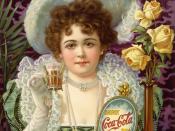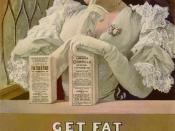For decades women have graced the pages of print media such as Cosmopolitan, Glamour, and Vogue. Each of these magazines began catering to women with an interest in men, sex, and personal success. Through the years, women's magazines in the United States and Europe have become less interested with issues of personal growth and more interested in fashion advertisement. This media trend has shaped a negative and unrealistic image of women, thus creating a devastating effect on the cultural standards of an ideal female.
The average woman sees between 400 and 600 advertisements per day, most of which emphasize thinness as a standard for female beauty. (Crouch) Unfortunately, the bodies idealized in the media are frequently atypical of normal, healthy women. These models require the expertise of make up artists, hair stylists, and computerized air-brushing techniques to achieve their look of excellence while society is tricked into believing this perfection is attainable.
When adolescent girls were asked what the ideal woman looked like, the girls said "she is 1.7 meters tall, weighs 45 kilograms, wears a size 5, and is blonde and blue-eyed."(Grogan). This answer could not have been more attractive to the creators of a recent ad campaign for Moschino Jeans. The jean advertisement features a female model "playing Barbie" The clothes and accessories are laid out next to the model as they would be in a plastic box in a toy store (see example A). The Moschino illustration objectifies all women suggesting that the perfect female is not human; she is instead a doll representing a female form whose only attribute is beauty.
When popular magazines consistently allow these types of ads on their pages, society takes on an idealistic view of women which results in lowered self-esteem, feelings of dissatisfaction, and stress among females. (About Face) Exposure...



Women in the Media
Thank you for an insightful discussion of the portrayal of women in the media. It can be devastating to young women to realize they will probably never achieve the deceiving images of glamor and beauty which are so glorified in the media. Rather than chasing a buck, the media would be doing a great service by honoring the efforts of ordinary women who work hard and achieve their goals. A bibliography would have been nice.
6 out of 6 people found this comment useful.